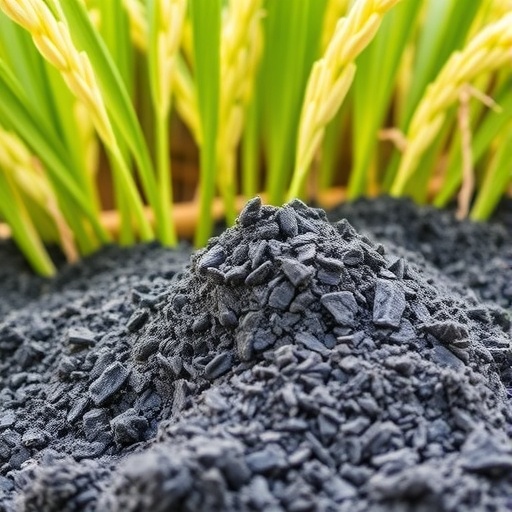In a groundbreaking study, researchers from India have unveiled the remarkable potential of rice straw ash, a byproduct of biomass-based power generation. With the world’s increasing energy demands and the urgent need for sustainable solutions, the characterization of agricultural waste has never been more critical. The study focuses on the microstructural, compositional, phase identification, and thermal analyses of rice straw ash, which could pave the way for innovative applications in various industries.
Rice straw is a significant agricultural residue, particularly in countries with extensive paddy cultivation like India. Traditionally, this biomass has been burnt in fields, contributing to environmental pollution and waste of valuable resources. By capturing and analyzing rice straw ash from biomass power plants, the study aims to provide insights into its composite materials and potential usefulness, transforming waste into valuable raw materials for construction, agriculture, and other sectors.
The microstructural analysis conducted in this research employs advanced techniques to investigate the ash’s morphology. Scanning electron microscopy (SEM) unveiled intricate details of the rice straw ash’s surface, illustrating the porous structure that is characteristic of this biomass-derived material. These structural features are crucial as they influence the material’s performance in various applications, including its ability to act as a lightweight aggregate or filler in composites.
In terms of composition, the researchers conducted a thorough elemental analysis using techniques such as X-ray fluorescence (XRF). The results demonstrated that rice straw ash comprises significant amounts of silica, alumina, and other trace elements. The high silica content, in particular, underscores the ash’s potential as a pozzolanic material, which can react with calcium hydroxide in the presence of water to form compounds with cement-like properties. This revelation invites further exploration into the use of rice straw ash in the development of sustainable construction materials.
Phase identification was another focal point of the study. X-ray diffraction (XRD) analysis provided insights into the crystalline structure of the rice straw ash. The results revealed several distinct phases, primarily consisting of amorphous silica and various crystalline compounds. Understanding these phases is vital not only for gauging the ash’s performance in construction materials but also for assessing its behavior during high-temperature applications such as in ceramics or glass production.
Thermal analysis was also an integral part of this comprehensive study. Techniques such as thermogravimetric analysis (TGA) and differential thermal analysis (DTA) were utilized to explore the thermal stability and decomposing behavior of rice straw ash. The researchers discovered that the ash exhibits considerable thermal resistance, making it an excellent candidate for applications in high-temperature environments. This thermal robustness can open new avenues for its usage in industries requiring durable and heat-resistant materials.
The implications of this research extend beyond mere material characterization. With an increasing focus on the circular economy, the ability to repurpose agricultural waste like rice straw into valuable materials is pivotal. Incorporating rice straw ash into building materials could significantly reduce the carbon footprint associated with traditional construction practices, offering a dual benefit of waste reduction and resource recovery.
As global awareness of environmental issues grows, the findings of this research resonate with the ongoing discussions surrounding climate change and resource conservation. By leveraging innovative agricultural practices and material science, it becomes feasible to transform agricultural waste into environmentally friendly building materials that align with sustainable development goals.
Moreover, the use of rice straw ash not only has positive implications for construction and material sciences but also contributes to rural economies. The potential for farmers and power plants to generate revenue from what was previously considered waste can lead to more sustainable agricultural practices and innovative waste management strategies.
In conclusion, the work conducted by Singh and Patel marks a significant step forward in waste management and material science. Their meticulous research illustrates that rice straw ash is not merely a byproduct; it’s a resource brimming with possibilities. As industries and researchers continue to seek eco-friendly alternatives, this study sets a precedent for future explorations into the transformation of agricultural waste into usable materials.
The findings of this research highlight a necessary shift in how society perceives agricultural byproducts, moving away from a waste-centric viewpoint toward a resource-oriented perspective is crucial for long-term sustainability. As we strive for a greener future, studies like this will play a vital role in shaping the discourse around renewable resources and innovative material applications.
This research not only adds a valuable dimension to the characterization of rice straw ash but also serves as a benchmark for further studies aimed at realizing the full potential of agricultural wastes. As the demand for sustainable materials grows, following the trail blazed by this research will be essential for future advancements in green technology.
Subject of Research: Rice straw ash as an agricultural waste material and its characterization for potential sustainable use.
Article Title: Characterization of rice straw ash: microstructural, compositional, phase identification, and thermal analyses of waste generated from biomass-based power plant.
Article References:
Singh, R., Patel, M. Characterization of rice straw ash: microstructural, compositional, phase identification, and thermal analyses of waste generated from biomass-based power plant.
Environ Sci Pollut Res (2025). https://doi.org/10.1007/s11356-025-36896-1
Image Credits: AI Generated
DOI:
Keywords: Rice straw ash, biomass, waste management, sustainable materials, microstructure, phase identification, thermal analysis, environmental impact, pozzolanic material, construction materials, circular economy.




